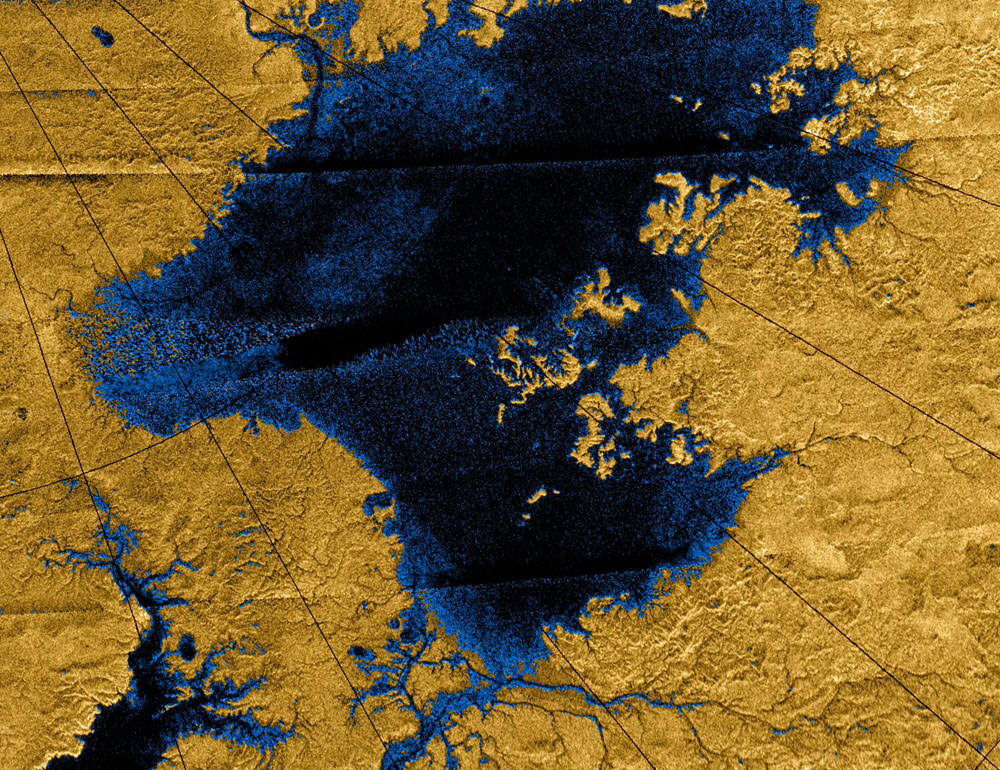Caption: Images from the Cassini mission show methane river networks draining into lakes in Titan’s north polar region. Credit: NASA/JPL/USG
Saturn’s largest moon, Titan has long been hidden beneath the thick shroud of its methane- and nitrogen-rich atmosphere. That all changed in 2004 when NASA’s Cassini mission was able to penetrate the haze and sent back detailed radar images of the surface. These showed an icy terrain, carved over millions of years, by rivers similar to those found here on Earth. However, Titan’s surface doesn’t look as old and weather-beaten as it should. The rivers have caused surprisingly little erosion and there are fewer impact craters than would be expected. So what is the secret to Titan’s youthful complexion?
Titan is around four billion years old, roughly the same age as the rest of the solar system. But the low number of impact craters put estimates of its surface at only between 100 million and one billion years old.
Researchers at MIT and the University of Tennessee at Knoxville have analyzed images of Titan’s river networks and suggest two possible explanations: either erosion on Titan is extremely slow, or some recent phenomena has wiped out older surface features.
Taylor Perron, the Cecil and Ida Green Assistant Professor of Geology at MIT explains, “It’s a surface that should have eroded much more than what we’re seeing, if the river networks have been active for a long time. It raises some very interesting questions about what has been happening on Titan in the last billion years.”
Perron suggests that geological processes on Titan may be like those we see here on Earth. Here too, impact craters are scarce, as plate tectonics, erupting volcanoes, advancing glaciers and river networks reshaped our planet’s surface over billions of years, so, on Titan, tectonic upheaval, cryovolcanic eruptions, erosion and sedimentation by rivers could be altering the surface.
Discovering which processes are at work is not easy. The images from Cassini are like aerial photos but with much coarser resolution. They are flat, with no information about a surface elevation or depth.
Perron and MIT graduate student Benjamin Black analyzed the images and mapped 52 prominent river networks from four regions on Titan. They then compared the images with a model of river network evolution developed by Perron. Their data depicts the evolution of a river over time, taking into account variables such as the strength of the underlying material and the rate of flow through the river channels. As a river erodes, it transforms from a long, spindly thread into a dense, treelike network of tributaries. Titan’s river networks have maintained their long and spindly composition. They compare with recently renewed landscapes here including volcanic terrain on the island of Kauai and recently glaciated landscapes in North America.
Besides Earth, Titan is the only world with an active hydrologic cycle forming active river networks. Titan’s surface temperature may be about 94 K and its rivers run with liquid methane but as Perron says “It’s a weirdly Earth-like place, even with this exotic combination of materials and temperatures, and so you can still say something definitive about the erosion. It’s the same physics.”
Below is a video of Black and Perron explaining their research:


What color(s) is a hydrocarbon lake?
afaik its a clear liquid, and it appears like titans brown colored atmosphere like Earth water appears like the blue color of the sky.
a brown lake like mud water. not too picturesque. thanks for info though.
I’m sure it’s very relaxing to Titanians on ocean cruises.
Water appears blue in large quantities (as in lakes and seas) – the sky contributes but not solely.
Primarily it’s a lot of scattering, among them the Rayleigh scattering that colors the sky, and much less reflections. (This is why indoor or glasses of water appear blue.)
“It is a common misconception that in large bodies, such as the oceans, the water’s color is blue due solely to the reflections from the sky on its surface.”
I would hazard to guess if you were standing on the shore looking at the lake that it would appear black for the most part. If there are ripples in the liquid it might glint off some light from the sun or Saturn. The over all brightness at day would be probably comparable to a moonlit night on Earth, and this lake would appear as a body of water at night on Earth. To get the color, which I think would be the orange-brown color of Titan you need to gather photons and integrate up the color on a photoplate or CCD..
It makes sense that water erodes more. Water is a polar molecule that electrostatically interacts with any surface. Water is amazingly destructive as an eroding liquid. Methane is nonpolar and probably erodes less due to friction contact with any surface due to electrostatic attractions.
LC
Very descriptive. Thanks. I like to imagine these things even if my human eyes never see make it there.
I’ll add that waters ampholytic ability, to act as both an acid and a base by giving off (H2O -> OH- + H+) or accept (H2O + H+ -> OH3+) protons, makes it nearly impossible to avoid chemical erosion.
Distilled water, which has lost all its buffering capacity from foreign mineral ions, is deadly for all sorts of technology.
Another good article Jenny
I don’t understand this. The surface was mapped with radar, but returned no depth information? What information did it return then? Surface texture only?
I want to go fishing THERE! Maybe I could use frozen anchovies for bait? Or better still anchovies frozen in Methane Hydrate? LOL~
I too was under the impression Cassini returned radar images showing Titan’s topography.